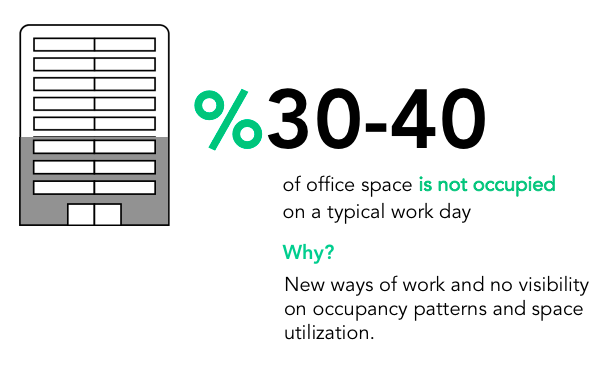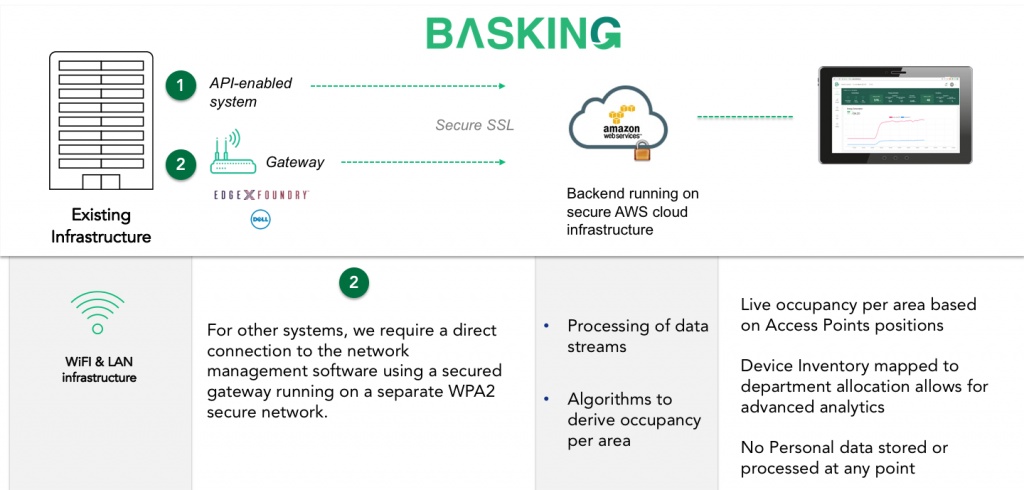Occupancy Analytics for Corporate Real Estate Managers
Allocate workspace according to the real-life use patterns, provide the required occupancy reports to the inspection agencies, and adapt your facility operations to the staff needs.
As a corporate real estate manager you’re focused on finding better ways to utilize and control the workspace and facilities around it. With the workplace rapidly changing and more and more companies looking to create a flexible and activity-based working environment, you need to be able to understand how the buildings are used in order to make informed decisions.

Facility managers currently lack information about how space is used. Traditional tools for measuring space utilization inside and outside of buildings do not offer enough detail or flexibility – most of the time best available data is a month in arrears with the granularity of one day. This is challenging for everyone involved:
- The facilities management team wants to know how space is currently being used in real time and how to tailor the building services to usage patterns.
- Employees want to be able to see which internal and external spaces have the capacity so they can tailor their behavior and attendance accordingly and
- Site facilities want to be able to continue to accommodate those with special needs, visitors, and third parties.
As corporate offices are converted to full agile working environments, most of the time the buildings will not have enough spaces to house all staff nominally based there.
To facilitate these changes, there is a new industry-wide focus on identifying, understanding, and controlling the utilization of space and facilities.
“ROI-first” approach to occupancy analytics in corporate real estate
There are multiple ways to track the building occupancy available now on the market – from PIR and ultrasonic sensors to security cameras and access management systems. With that said, sensors can have a hard time detecting stationary occupants and are expensive to install in existing buildings. It’s important to balance the budget requirements, tenants’ comfort, and most importantly privacy requirements – something that can be problematic with the use of cameras and other granular sensors.
Basking’s ROI-first approach means that we first establish the connection with the existing systems, using the WiFi, access management, and energy metering devices to unlock your real-time space utilisation and occupancy data – quickly and at no additional hardware cost.
Accurate, Secure, and Easy to Maintain

Leveraging the existing WiFi infrastructure in the office buildings allows Basking to provide highly detailed occupancy data at a very high ROI to its customers. A group of researchers from UC San Diego and Carnegie Mellon University used WiFi infrastructure to detect occupancy in the buildings and have accurately determined the occupancy in office spaces 86% of the time, with 6.2% false negative errors.
Data-Driven Personnel and Costs Allocation
Data-driven personnel allocation allows employers to focus on key office sites, and base up to 30% more people at these locations than there is building capacity for. This provide for a significant decrease of the overall real estate-related OPEX.
Traditional resource charging process is based on fixed desk allocations, which is clearly problematic when the companies are moving to more agile spaces. With Basking, our customers can accurately identify the teams or business units who consume space or site facilities, and so can accurately recharge business units for consumption.
By using Basking across all of your assets, you can see how each office in your portfolio is behaving in terms of occupancy and space utilization and compare similar buildings over time. This data is then used to better plan the staff allocation, lease handling and facilities management. It will also enable the company to create a workplace that is easy and efficient for the end user, providing a consistent interface and user experience across all sites and locations. The end result is a combination of lower costs and increased employee productivity and satisfaction.
Get started
If you want to know more about how our product works or have additional questions, please reach out to us:
